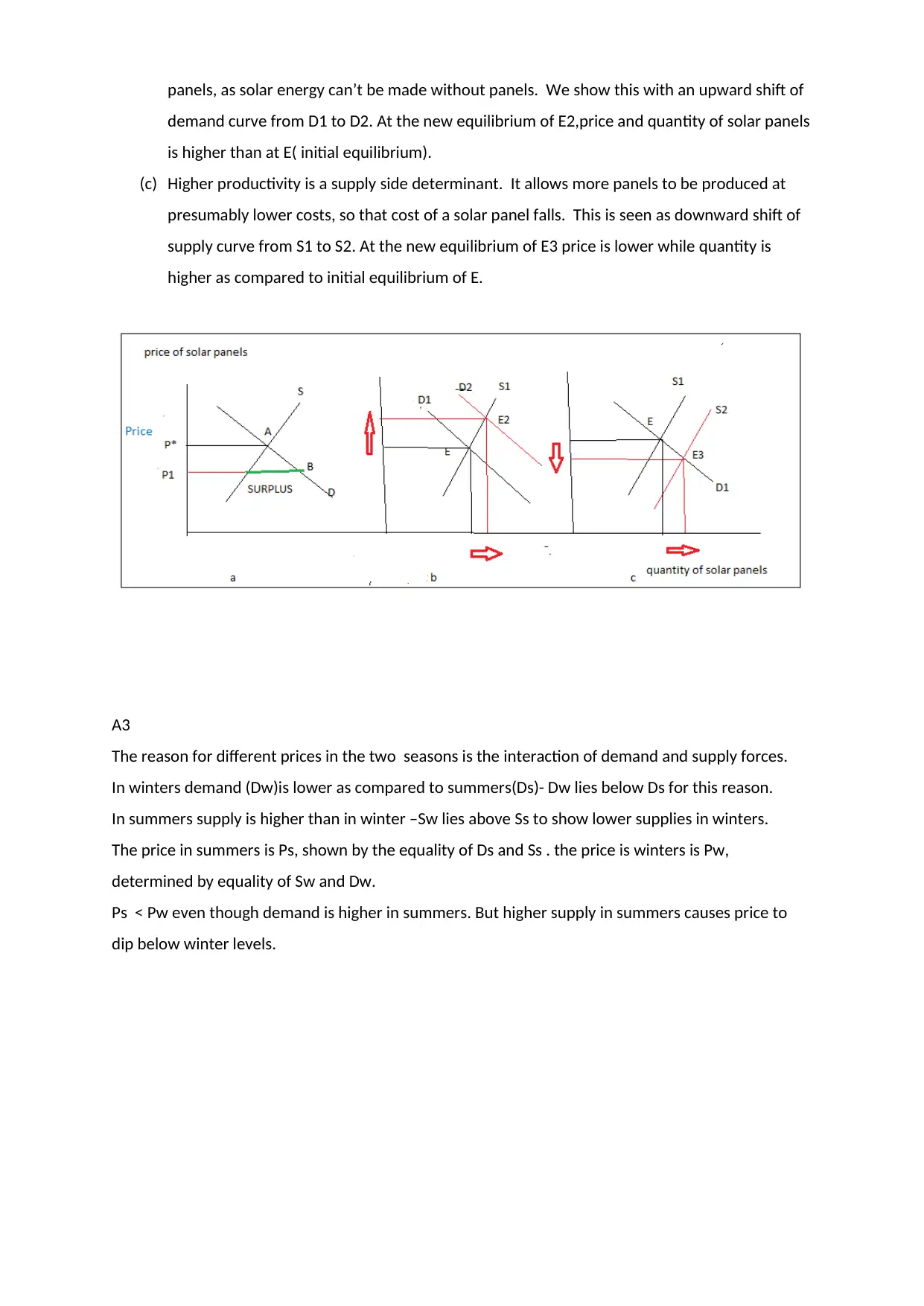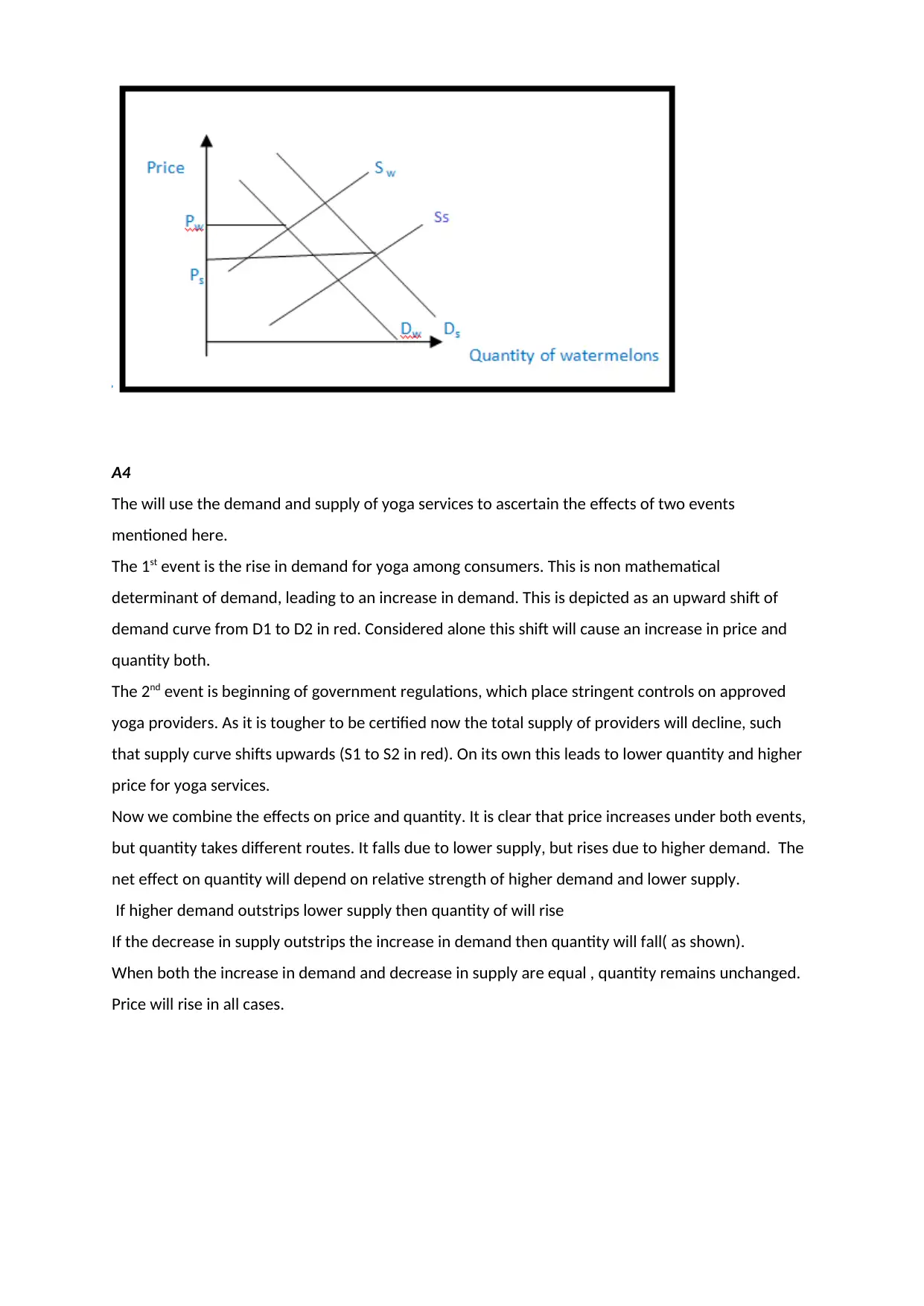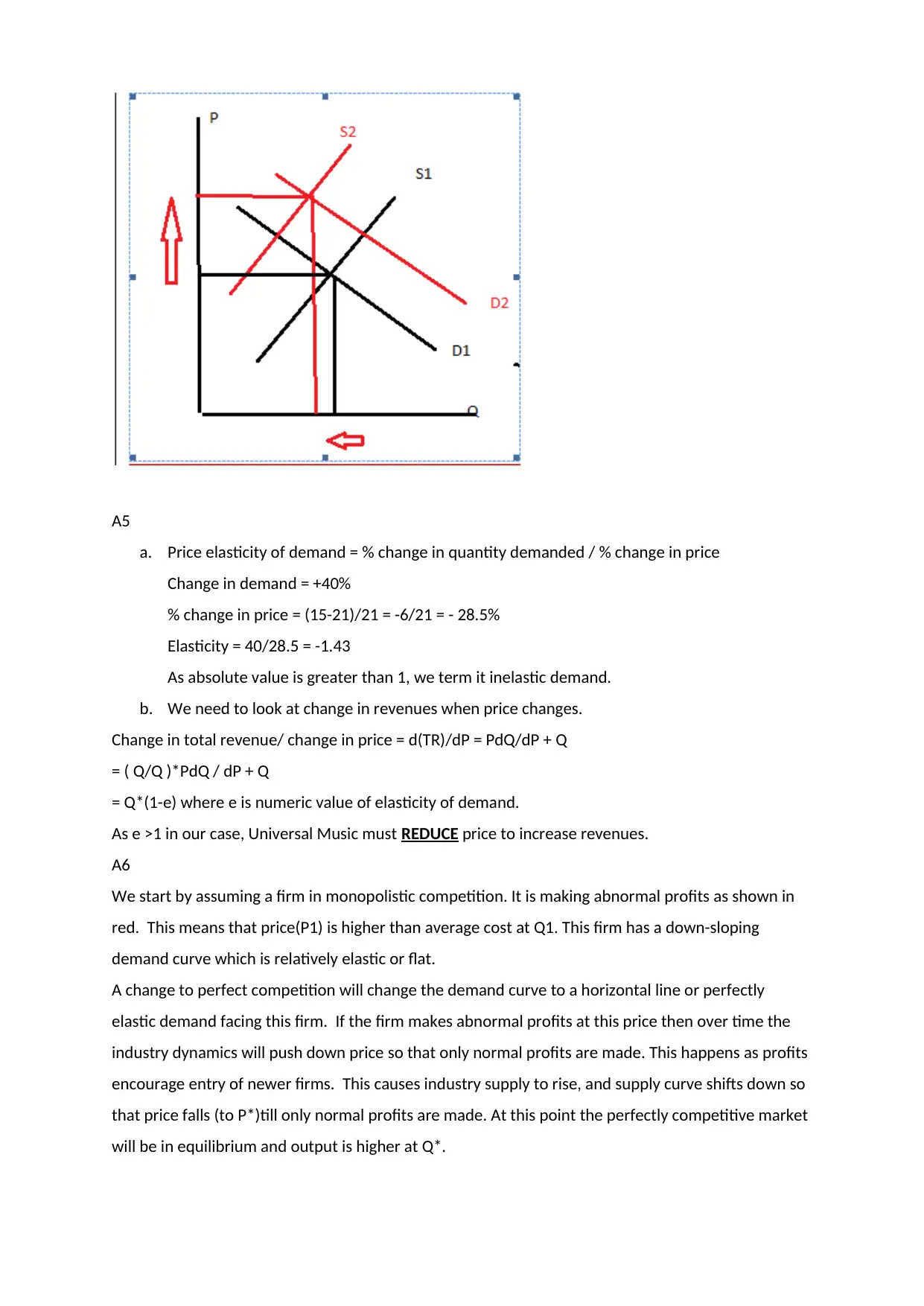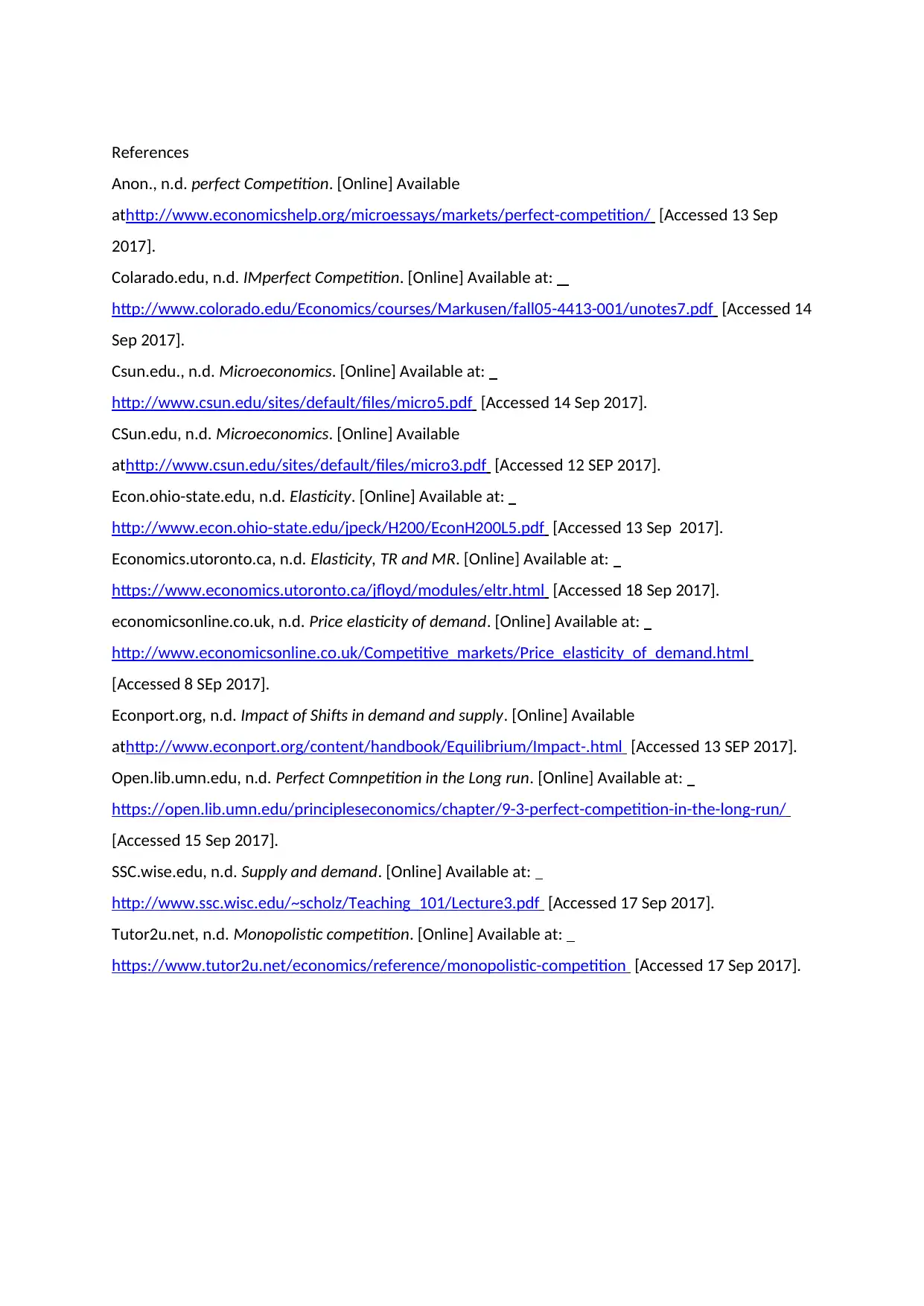Understanding Demand Elasticity and Market Structures
VerifiedAdded on 2020/04/01
|6
|1355
|296
AI Summary
The assignment provides a comprehensive analysis of various economic concepts including the effects of price changes on revenues, understanding demand elasticity, shifts in demand and supply curves, and transitions between different types of market structures such as monopolistic and perfect competition. It emphasizes calculations and theoretical knowledge application to understand how firms adjust prices for revenue optimization and how industry dynamics influence long-term equilibrium in competitive markets.

Question 1
A change in quantity demanded of hats and change in demand of hats can be differentiated on the
basis of CAUSE and GRAPHICAL analysis.
The cause of a change in quantity demanded of hats is a change in price of hats. If price falls fromP1
to P2 (shown as A to B) then quantity demanded rises from Q1 to Q2. This is shown as movement
ALONG the curve from point A to B.
An increase in demand of hats is caused by a change in other determinants of demand for hats.
These may include- change in income or price of a substitute or complementary good, or a general
change in preferences. It is shown as a SHIFT of the curve from D1 to D2. This right shift is an
indication that demand for hats has risen. The opposite is a fall in demand, shown by the downward
shift of the demand curve to D3
A2
In each case given we use demand supply analysis. Each event is shown with shifts in demand and/or
supply curves to determine the effect on price and quantity.
(a) The event is - change in price of panels which disturbs the initial equilibrium at A with price
P*. As mentioned in question1, the lower price is shown as a movement along the curve
from A to B. At the price of P1, there is excess supply, and this point B is a disequilibrium
point.
(b) We assume that electricity and solar energy are close substitutes. Any change in price of
electricity will affect demand curve in terms of shifting it. It is expected that more expensive
electricity will cause higher demand for solar energy. This will drive the demand for solar
A change in quantity demanded of hats and change in demand of hats can be differentiated on the
basis of CAUSE and GRAPHICAL analysis.
The cause of a change in quantity demanded of hats is a change in price of hats. If price falls fromP1
to P2 (shown as A to B) then quantity demanded rises from Q1 to Q2. This is shown as movement
ALONG the curve from point A to B.
An increase in demand of hats is caused by a change in other determinants of demand for hats.
These may include- change in income or price of a substitute or complementary good, or a general
change in preferences. It is shown as a SHIFT of the curve from D1 to D2. This right shift is an
indication that demand for hats has risen. The opposite is a fall in demand, shown by the downward
shift of the demand curve to D3
A2
In each case given we use demand supply analysis. Each event is shown with shifts in demand and/or
supply curves to determine the effect on price and quantity.
(a) The event is - change in price of panels which disturbs the initial equilibrium at A with price
P*. As mentioned in question1, the lower price is shown as a movement along the curve
from A to B. At the price of P1, there is excess supply, and this point B is a disequilibrium
point.
(b) We assume that electricity and solar energy are close substitutes. Any change in price of
electricity will affect demand curve in terms of shifting it. It is expected that more expensive
electricity will cause higher demand for solar energy. This will drive the demand for solar
Paraphrase This Document
Need a fresh take? Get an instant paraphrase of this document with our AI Paraphraser

panels, as solar energy can’t be made without panels. We show this with an upward shift of
demand curve from D1 to D2. At the new equilibrium of E2,price and quantity of solar panels
is higher than at E( initial equilibrium).
(c) Higher productivity is a supply side determinant. It allows more panels to be produced at
presumably lower costs, so that cost of a solar panel falls. This is seen as downward shift of
supply curve from S1 to S2. At the new equilibrium of E3 price is lower while quantity is
higher as compared to initial equilibrium of E.
A3
The reason for different prices in the two seasons is the interaction of demand and supply forces.
In winters demand (Dw)is lower as compared to summers(Ds)- Dw lies below Ds for this reason.
In summers supply is higher than in winter –Sw lies above Ss to show lower supplies in winters.
The price in summers is Ps, shown by the equality of Ds and Ss . the price is winters is Pw,
determined by equality of Sw and Dw.
Ps < Pw even though demand is higher in summers. But higher supply in summers causes price to
dip below winter levels.
demand curve from D1 to D2. At the new equilibrium of E2,price and quantity of solar panels
is higher than at E( initial equilibrium).
(c) Higher productivity is a supply side determinant. It allows more panels to be produced at
presumably lower costs, so that cost of a solar panel falls. This is seen as downward shift of
supply curve from S1 to S2. At the new equilibrium of E3 price is lower while quantity is
higher as compared to initial equilibrium of E.
A3
The reason for different prices in the two seasons is the interaction of demand and supply forces.
In winters demand (Dw)is lower as compared to summers(Ds)- Dw lies below Ds for this reason.
In summers supply is higher than in winter –Sw lies above Ss to show lower supplies in winters.
The price in summers is Ps, shown by the equality of Ds and Ss . the price is winters is Pw,
determined by equality of Sw and Dw.
Ps < Pw even though demand is higher in summers. But higher supply in summers causes price to
dip below winter levels.

A4
The will use the demand and supply of yoga services to ascertain the effects of two events
mentioned here.
The 1st event is the rise in demand for yoga among consumers. This is non mathematical
determinant of demand, leading to an increase in demand. This is depicted as an upward shift of
demand curve from D1 to D2 in red. Considered alone this shift will cause an increase in price and
quantity both.
The 2nd event is beginning of government regulations, which place stringent controls on approved
yoga providers. As it is tougher to be certified now the total supply of providers will decline, such
that supply curve shifts upwards (S1 to S2 in red). On its own this leads to lower quantity and higher
price for yoga services.
Now we combine the effects on price and quantity. It is clear that price increases under both events,
but quantity takes different routes. It falls due to lower supply, but rises due to higher demand. The
net effect on quantity will depend on relative strength of higher demand and lower supply.
If higher demand outstrips lower supply then quantity of will rise
If the decrease in supply outstrips the increase in demand then quantity will fall( as shown).
When both the increase in demand and decrease in supply are equal , quantity remains unchanged.
Price will rise in all cases.
The will use the demand and supply of yoga services to ascertain the effects of two events
mentioned here.
The 1st event is the rise in demand for yoga among consumers. This is non mathematical
determinant of demand, leading to an increase in demand. This is depicted as an upward shift of
demand curve from D1 to D2 in red. Considered alone this shift will cause an increase in price and
quantity both.
The 2nd event is beginning of government regulations, which place stringent controls on approved
yoga providers. As it is tougher to be certified now the total supply of providers will decline, such
that supply curve shifts upwards (S1 to S2 in red). On its own this leads to lower quantity and higher
price for yoga services.
Now we combine the effects on price and quantity. It is clear that price increases under both events,
but quantity takes different routes. It falls due to lower supply, but rises due to higher demand. The
net effect on quantity will depend on relative strength of higher demand and lower supply.
If higher demand outstrips lower supply then quantity of will rise
If the decrease in supply outstrips the increase in demand then quantity will fall( as shown).
When both the increase in demand and decrease in supply are equal , quantity remains unchanged.
Price will rise in all cases.
⊘ This is a preview!⊘
Do you want full access?
Subscribe today to unlock all pages.

Trusted by 1+ million students worldwide

A5
a. Price elasticity of demand = % change in quantity demanded / % change in price
Change in demand = +40%
% change in price = (15-21)/21 = -6/21 = - 28.5%
Elasticity = 40/28.5 = -1.43
As absolute value is greater than 1, we term it inelastic demand.
b. We need to look at change in revenues when price changes.
Change in total revenue/ change in price = d(TR)/dP = PdQ/dP + Q
= ( Q/Q )*PdQ / dP + Q
= Q*(1-e) where e is numeric value of elasticity of demand.
As e >1 in our case, Universal Music must REDUCE price to increase revenues.
A6
We start by assuming a firm in monopolistic competition. It is making abnormal profits as shown in
red. This means that price(P1) is higher than average cost at Q1. This firm has a down-sloping
demand curve which is relatively elastic or flat.
A change to perfect competition will change the demand curve to a horizontal line or perfectly
elastic demand facing this firm. If the firm makes abnormal profits at this price then over time the
industry dynamics will push down price so that only normal profits are made. This happens as profits
encourage entry of newer firms. This causes industry supply to rise, and supply curve shifts down so
that price falls (to P*)till only normal profits are made. At this point the perfectly competitive market
will be in equilibrium and output is higher at Q*.
a. Price elasticity of demand = % change in quantity demanded / % change in price
Change in demand = +40%
% change in price = (15-21)/21 = -6/21 = - 28.5%
Elasticity = 40/28.5 = -1.43
As absolute value is greater than 1, we term it inelastic demand.
b. We need to look at change in revenues when price changes.
Change in total revenue/ change in price = d(TR)/dP = PdQ/dP + Q
= ( Q/Q )*PdQ / dP + Q
= Q*(1-e) where e is numeric value of elasticity of demand.
As e >1 in our case, Universal Music must REDUCE price to increase revenues.
A6
We start by assuming a firm in monopolistic competition. It is making abnormal profits as shown in
red. This means that price(P1) is higher than average cost at Q1. This firm has a down-sloping
demand curve which is relatively elastic or flat.
A change to perfect competition will change the demand curve to a horizontal line or perfectly
elastic demand facing this firm. If the firm makes abnormal profits at this price then over time the
industry dynamics will push down price so that only normal profits are made. This happens as profits
encourage entry of newer firms. This causes industry supply to rise, and supply curve shifts down so
that price falls (to P*)till only normal profits are made. At this point the perfectly competitive market
will be in equilibrium and output is higher at Q*.
Paraphrase This Document
Need a fresh take? Get an instant paraphrase of this document with our AI Paraphraser


References
Anon., n.d. perfect Competition. [Online] Available
athttp://www.economicshelp.org/microessays/markets/perfect-competition/ [Accessed 13 Sep
2017].
Colarado.edu, n.d. IMperfect Competition. [Online] Available at:
http://www.colorado.edu/Economics/courses/Markusen/fall05-4413-001/unotes7.pdf [Accessed 14
Sep 2017].
Csun.edu., n.d. Microeconomics. [Online] Available at:
http://www.csun.edu/sites/default/files/micro5.pdf [Accessed 14 Sep 2017].
CSun.edu, n.d. Microeconomics. [Online] Available
athttp://www.csun.edu/sites/default/files/micro3.pdf [Accessed 12 SEP 2017].
Econ.ohio-state.edu, n.d. Elasticity. [Online] Available at:
http://www.econ.ohio-state.edu/jpeck/H200/EconH200L5.pdf [Accessed 13 Sep 2017].
Economics.utoronto.ca, n.d. Elasticity, TR and MR. [Online] Available at:
https://www.economics.utoronto.ca/jfloyd/modules/eltr.html [Accessed 18 Sep 2017].
economicsonline.co.uk, n.d. Price elasticity of demand. [Online] Available at:
http://www.economicsonline.co.uk/Competitive_markets/Price_elasticity_of_demand.html
[Accessed 8 SEp 2017].
Econport.org, n.d. Impact of Shifts in demand and supply. [Online] Available
athttp://www.econport.org/content/handbook/Equilibrium/Impact-.html [Accessed 13 SEP 2017].
Open.lib.umn.edu, n.d. Perfect Comnpetition in the Long run. [Online] Available at:
https://open.lib.umn.edu/principleseconomics/chapter/9-3-perfect-competition-in-the-long-run/
[Accessed 15 Sep 2017].
SSC.wise.edu, n.d. Supply and demand. [Online] Available at:
http://www.ssc.wisc.edu/~scholz/Teaching_101/Lecture3.pdf [Accessed 17 Sep 2017].
Tutor2u.net, n.d. Monopolistic competition. [Online] Available at:
https://www.tutor2u.net/economics/reference/monopolistic-competition [Accessed 17 Sep 2017].
Anon., n.d. perfect Competition. [Online] Available
athttp://www.economicshelp.org/microessays/markets/perfect-competition/ [Accessed 13 Sep
2017].
Colarado.edu, n.d. IMperfect Competition. [Online] Available at:
http://www.colorado.edu/Economics/courses/Markusen/fall05-4413-001/unotes7.pdf [Accessed 14
Sep 2017].
Csun.edu., n.d. Microeconomics. [Online] Available at:
http://www.csun.edu/sites/default/files/micro5.pdf [Accessed 14 Sep 2017].
CSun.edu, n.d. Microeconomics. [Online] Available
athttp://www.csun.edu/sites/default/files/micro3.pdf [Accessed 12 SEP 2017].
Econ.ohio-state.edu, n.d. Elasticity. [Online] Available at:
http://www.econ.ohio-state.edu/jpeck/H200/EconH200L5.pdf [Accessed 13 Sep 2017].
Economics.utoronto.ca, n.d. Elasticity, TR and MR. [Online] Available at:
https://www.economics.utoronto.ca/jfloyd/modules/eltr.html [Accessed 18 Sep 2017].
economicsonline.co.uk, n.d. Price elasticity of demand. [Online] Available at:
http://www.economicsonline.co.uk/Competitive_markets/Price_elasticity_of_demand.html
[Accessed 8 SEp 2017].
Econport.org, n.d. Impact of Shifts in demand and supply. [Online] Available
athttp://www.econport.org/content/handbook/Equilibrium/Impact-.html [Accessed 13 SEP 2017].
Open.lib.umn.edu, n.d. Perfect Comnpetition in the Long run. [Online] Available at:
https://open.lib.umn.edu/principleseconomics/chapter/9-3-perfect-competition-in-the-long-run/
[Accessed 15 Sep 2017].
SSC.wise.edu, n.d. Supply and demand. [Online] Available at:
http://www.ssc.wisc.edu/~scholz/Teaching_101/Lecture3.pdf [Accessed 17 Sep 2017].
Tutor2u.net, n.d. Monopolistic competition. [Online] Available at:
https://www.tutor2u.net/economics/reference/monopolistic-competition [Accessed 17 Sep 2017].
⊘ This is a preview!⊘
Do you want full access?
Subscribe today to unlock all pages.

Trusted by 1+ million students worldwide
1 out of 6
Related Documents
Your All-in-One AI-Powered Toolkit for Academic Success.
+13062052269
info@desklib.com
Available 24*7 on WhatsApp / Email
![[object Object]](/_next/static/media/star-bottom.7253800d.svg)
Unlock your academic potential
Copyright © 2020–2025 A2Z Services. All Rights Reserved. Developed and managed by ZUCOL.





